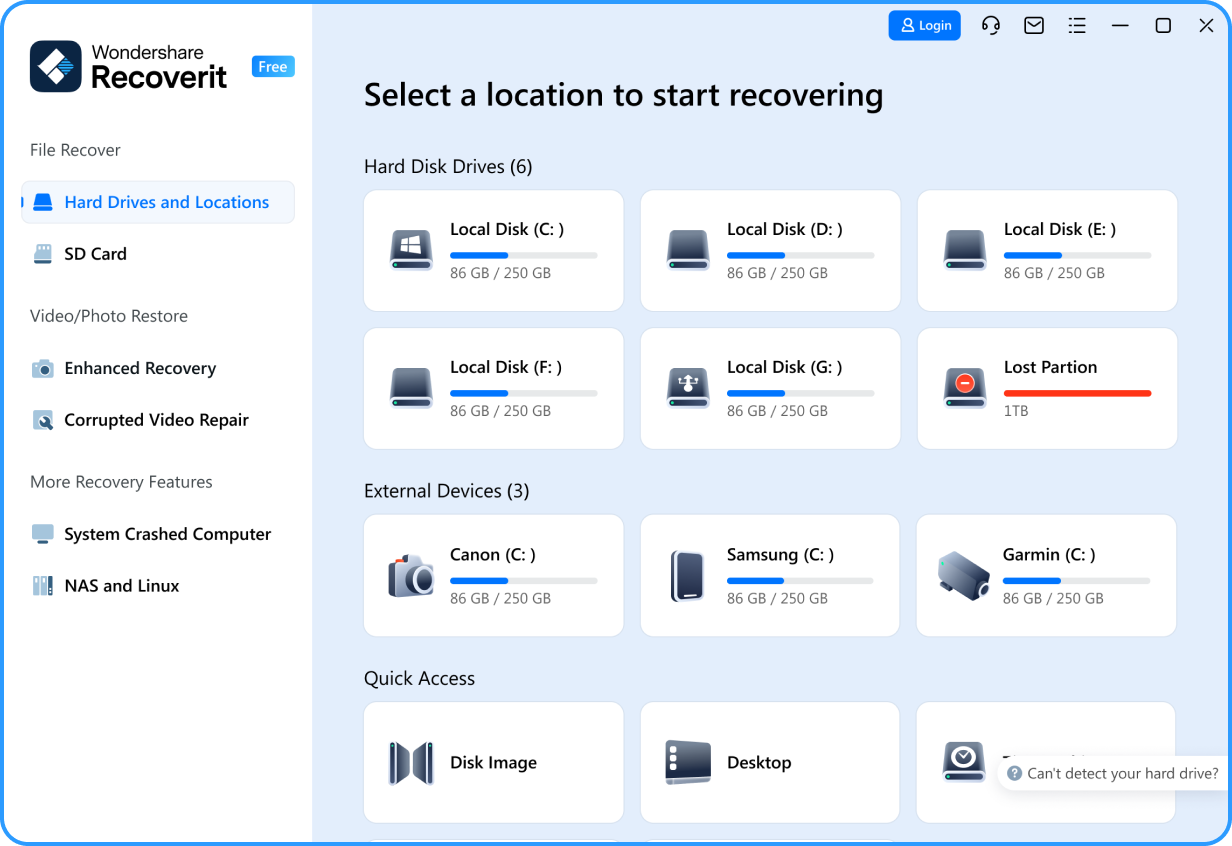Do you ever wonder how your computer keeps track of all your files and folders? It's like a giant library, but instead of books, it's full of digital information. One system that helps organize this digital library is called the BFS File System. But what exactly is BFS, and why should you care about it?
Want to learn about a file system that can make your computer run smoother and faster? The BFS File System might be just what you're looking for. In this article, we'll explore everything you need to know about BFS, from its basic features to how it compares with other systems.
We'll even show you how to recover files if something goes wrong. So, let's dive in and uncover the secrets of the BFS File System!
In this article
Part 1: What is BFS File System?
The BFS File System, which stands for Be File System, is a way of organizing and storing data on your computer. It was created for the BeOS operating system but has since been used in other systems too. Think of BFS as a super-organized closet for your digital stuff. It helps your computer find, save, and manage files quickly and efficiently.
When you're wondering "What is BFS File System," imagine it as the brain that remembers where everything is stored on your computer's hard drive.
Related Video >>: What is a File System?
Part 2: Key Features of BFS File System
Let's look at some of the cool things that make the BFS File System special:
- Fast Performance: BFS is like a speedy librarian, finding your files in no time.
- Large File Support: It can handle really big files, like long movies or huge databases.
- Journaling: This is like keeping a diary of all file changes, which helps prevent data loss.
- Attributes: You can add extra information to files, making them easier to find later.
- Simple Design: BFS is not complicated, which means it's less likely to have problems.
- Space Efficiency: It uses your hard drive space wisely, not wasting any room.
- Quick Recovery: If your computer crashes, BFS helps you get your files back faster.
- 64-bit Support: This means it can work with very large hard drives and lots of files.
These features are what make people ask, "How do I open a BFS file?" because they want to use this efficient system.
Part 3: Pros and Cons of BFS File System
When considering the pros and cons of BFS file system, it's important to weigh these factors based on your specific needs.
Part 4: DFS vs BFS: Which is Better and Why?

To understand how BFS compares to other systems, let's look at BFS vs DFS (Depth-First Search) file systems:
| Feature | BFS (Breadth-First Search) | DFS (Depth-First Search) |
| Search Pattern | Checks all neighboring nodes at the current level. | Goes as deep as possible down each path. |
| Memory Usage | Uses more memory | Uses less memory |
| Optimal Path | Finds the shortest path | May not find the shortest path |
| Speed for Search | Slower for deep searches | Faster for deep searches |
| Backtracking | Less backtracking | More backtracking |
| Use Case | Best for shallow, wide data structures | Best for deep, narrow data structures |
In the DFS vs BFS debate, the choice depends on your specific needs. BFS is often better for file systems because it's more efficient at finding nearby files quickly.
Part 5: How to Recover Files from BFS File System
Data loss can occur unexpectedly, causing stress and disruption. When working with BFS (Be File System), file recovery can be challenging. Fortunately, specialized tools like Recoverit make the process easier.
Why Choose Recoverit?
- User-friendly interface
- High recovery success rate
- Supports various file types
- Recovers data from multiple devices
Here's a simple guide:
Step 1: Install Recoverit on your computer. Launch the program and select the BFS drive you want to recover files from. Click Start.

Step 2: Wait for the scanning process.

Step 3: Preview the files Recoverit finds to make sure they're what you're looking for. Select the files you want to get back and click Recover. Choose a safe place to save your recovered files.

Additional Tips for Using Recoverit with BFS File System:
- File Formats: Recoverit supports a wide range of file formats, including documents, photos, videos, and audio files. It's particularly good at recovering media files from BFS systems.
- Deep Scan: If the standard scan doesn't find your files, use the "Advanced" or "Deep Scan" option. This takes longer but can find more deeply hidden or fragmented files.
- Filter Results: Use the filter options in Recoverit to narrow down your search by file type, size, or date modified. This can be especially helpful when dealing with BFS file systems that might have a complex directory structure.
- Recover to Cloud: Some versions of Recoverit allow you to recover files directly to cloud storage services. This can be useful if you're low on local storage space.
- Regular Backups: While Recoverit is excellent for recovering files from BFS File System, it's always best to maintain regular backups to prevent data loss in the first place.
Remember, it's always better to prevent data loss in the first place by backing up your important files regularly.
Part 6: Tips to Recover Files From BFS File System
Here are some helpful tips to make file recovery easier:
- Stop using the drive as soon as you realize files are missing to prevent overwriting.
- Use a reliable recovery tool like Recoverit that supports BFS.
- Recover files to a different drive to avoid potential data conflicts.
- Keep your BFS file system updated to the latest version for better stability.
- Regularly check and repair your file system to prevent data corruption.
- Consider using cloud backups as an extra safety measure.
- If DIY methods fail, consult a professional data recovery service.
By following these tips, you increase your chances of successfully recovering lost files from your BFS File System.
Conclusion
The BFS File System is a powerful tool for organizing and managing your digital files. We've explored what BFS is, its key features, and how it compares to other systems like DFS. We've also looked at the pros and cons of using BFS, which can help you decide if it's the right choice for your needs.
Remember, no matter what file system you use, it's always important to keep your data safe. Regular backups and proper maintenance can save you from the headache of data loss. If you do find yourself needing to recover files from a BFS File System, now you have the knowledge and tools to do so. Whether you're a tech enthusiast or just someone who wants their computer to run smoothly, understanding file systems like BFS can make your digital life much easier.
Try Wondershare Recoverit to Recover Your Vital Data

FAQ
-
What is BFS File System and why is it important?
BFS File System, or Be File System, is a method of organizing and storing data on computers. It's important because it offers fast performance, reliable data storage, and efficient use of hard drive space. BFS helps your computer quickly find and manage files, which can make your overall computing experience smoother and more efficient. Understanding what BFS File System is can help you make informed decisions about how to best organize and protect your digital data. -
How do I open a BFS file?
To open a BFS file, you typically need an operating system or software that supports the BFS format. If you're using a BeOS-compatible system, you can open BFS files directly. For other operating systems, you might need special software or drivers. Some file archiving tools can also read BFS file systems. If you're wondering "How do I open a BFS file?" on a non-BFS system, you may need to use a virtual machine running BeOS or a BFS-compatible OS. Always make sure you trust the source of any software you use to open unfamiliar file types. -
What are the main differences between DFS and BFS in file systems?
The main differences between DFS (Depth-First Search) and BFS (Breadth-First Search) in file systems lie in how they explore and organize data. BFS searches all neighboring nodes at the current depth before moving to the next level, making it efficient for finding files in nearby directories. DFS, on the other hand, explores as far as possible along each branch before backtracking. This makes DFS better for deep, narrow directory structures. In the context of "DFS vs BFS," BFS is often preferred for file systems because it's more efficient at finding and accessing frequently used files, which are typically stored in nearby locations.



 ChatGPT
ChatGPT
 Perplexity
Perplexity
 Google AI Mode
Google AI Mode
 Grok
Grok























